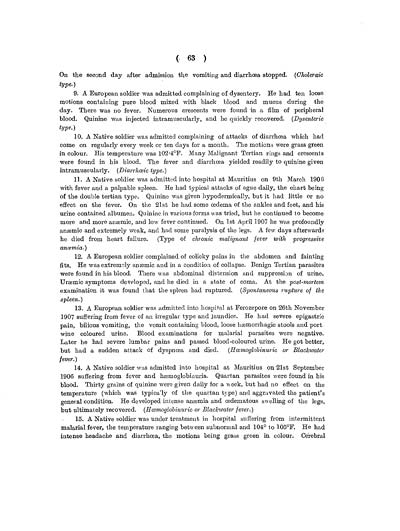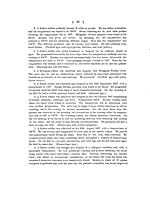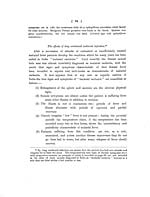Medicine - Disease > Malarial fevers
(73) Page 63
Download files
Individual page:
Thumbnail gallery: Grid view | List view

(63)
On the second day after admission the vomiting and diarrha stopped. (Choleraic
type.)
9. A European soldier was admitted complaining of dysentery. He had ten loose
motions containing pure blood mixed with black blood and mucus during the
day. There was no fever. Numerous crescents were found in a film of peripheral
blood. Quinine was injected intramuscularly, and he quickly recovered. (Dysenteric
type.)
10. A Native soldier was admitted complaining of attacks of diarrha which had
come on regularly every week or ten days for a month. The motions were grass green
in colour. His temperature was 1024F. Many Malignant Tertian rings and crescents
were found in his blood. The fever and diarrha yielded readily to quinine given
intramuscularly. (Diarrhic type.)
11. A Native soldier was admitted into hospital at Mauritius on 9th March 1906
with fever and a palpable spleen. He had typical attacks of ague daily, the chart being
of the double tertian type. Quinine was given hypodermically, but it had little or no
effect on the fever. On the 21st he had some dema of the ankles and feet, and his
urine contained albumen. Quinine in various forms was tried, but he continued to become
more and more anmic, and low fever continued. On 1st April 1907 he was profoundly
anmic and extremely weak, and had some paralysis of the legs. A few days afterwards
he died from heart failure. (Type of chronic malignant fever with progressive
anmia.)
12. A European soldier complained of colicky pains in the abdomen and fainting
fits. He was extremely anmic and in a condition of collapse. Benign Tertian parasites
were found in his blood. There was abdominal distension and suppression of urine.
Urmic symptoms developed, and he died in a state of coma. At the post-mortem
examination it was found that the spleen had ruptured. (Spontaneous \ill\upture of the
spleen.)
13. A European soldier was admitted into hospital at Ferozepore on 26th November
1907 suffering from fever of an irregular type and Jaundice. He had severe epigastric
pain, bilious vomiting, the vomit containing blood, loose hsmorrhagic stools and port
wine coloured urine. Blood examinations for malarial parasites were negative.
Later he had severe lumbar pains and passed blood-coloured urine. He got better,
but had a sudden attack of dyspna and died. (Hmoglobinuric or Blackwater
fever.)
14. A Native soldier was admitted into hospital at Mauritius on 21st September
1906 suffering from fever and hmoglobinuria. Quartan parasites were found in his
blood. Thirty grains of quinine were given daily for a week, but had no effect on the
temperature (which was typically of the quartan type) and aggravated the patient's
general condition. He developed intense anmia and dematous swelling of the legs,
but ultimately recovered. (Hmoglobinuric or Blackwater fever.)
15. A Native soldier was under treatment in hospital suffering from intermittent
malarial fever, the temperature ranging between subnormal and 104 to 105F. He had
intense headache and diarrha, the motions being grass green in colour. Cerebral
On the second day after admission the vomiting and diarrha stopped. (Choleraic
type.)
9. A European soldier was admitted complaining of dysentery. He had ten loose
motions containing pure blood mixed with black blood and mucus during the
day. There was no fever. Numerous crescents were found in a film of peripheral
blood. Quinine was injected intramuscularly, and he quickly recovered. (Dysenteric
type.)
10. A Native soldier was admitted complaining of attacks of diarrha which had
come on regularly every week or ten days for a month. The motions were grass green
in colour. His temperature was 1024F. Many Malignant Tertian rings and crescents
were found in his blood. The fever and diarrha yielded readily to quinine given
intramuscularly. (Diarrhic type.)
11. A Native soldier was admitted into hospital at Mauritius on 9th March 1906
with fever and a palpable spleen. He had typical attacks of ague daily, the chart being
of the double tertian type. Quinine was given hypodermically, but it had little or no
effect on the fever. On the 21st he had some dema of the ankles and feet, and his
urine contained albumen. Quinine in various forms was tried, but he continued to become
more and more anmic, and low fever continued. On 1st April 1907 he was profoundly
anmic and extremely weak, and had some paralysis of the legs. A few days afterwards
he died from heart failure. (Type of chronic malignant fever with progressive
anmia.)
12. A European soldier complained of colicky pains in the abdomen and fainting
fits. He was extremely anmic and in a condition of collapse. Benign Tertian parasites
were found in his blood. There was abdominal distension and suppression of urine.
Urmic symptoms developed, and he died in a state of coma. At the post-mortem
examination it was found that the spleen had ruptured. (Spontaneous \ill\upture of the
spleen.)
13. A European soldier was admitted into hospital at Ferozepore on 26th November
1907 suffering from fever of an irregular type and Jaundice. He had severe epigastric
pain, bilious vomiting, the vomit containing blood, loose hsmorrhagic stools and port
wine coloured urine. Blood examinations for malarial parasites were negative.
Later he had severe lumbar pains and passed blood-coloured urine. He got better,
but had a sudden attack of dyspna and died. (Hmoglobinuric or Blackwater
fever.)
14. A Native soldier was admitted into hospital at Mauritius on 21st September
1906 suffering from fever and hmoglobinuria. Quartan parasites were found in his
blood. Thirty grains of quinine were given daily for a week, but had no effect on the
temperature (which was typically of the quartan type) and aggravated the patient's
general condition. He developed intense anmia and dematous swelling of the legs,
but ultimately recovered. (Hmoglobinuric or Blackwater fever.)
15. A Native soldier was under treatment in hospital suffering from intermittent
malarial fever, the temperature ranging between subnormal and 104 to 105F. He had
intense headache and diarrha, the motions being grass green in colour. Cerebral
Set display mode to: Large image | Zoom image | Transcription
Images and transcriptions on this page, including medium image downloads, may be used under the Creative Commons Attribution 4.0 International Licence unless otherwise stated. ![]()
| India Papers > Medicine - Disease > Malarial fevers > (73) Page 63 |
|---|
| Permanent URL | https://digital.nls.uk/74558996 |
|---|




